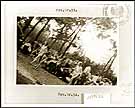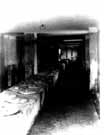
|
|
|

|

|

|

|
|
Click on an image to see a larger, more detailed picture.
|
|
|
|
|
| 1944: Desperate Acts |

|
pg. 553 |

|
|
|
|
| |
 Among the things that made Auschwitz the most horrific of the camps was the infamous selection process that took place upon the prisoners' arrival. This photograph shows an SS man deciding who will die immediately in the gas chambers and who will work himself or herself to death as a slave of the "master race." Children and pregnant women, who represented the future of the Jewish "race," were universally selected for the gas chambers.
Among the things that made Auschwitz the most horrific of the camps was the infamous selection process that took place upon the prisoners' arrival. This photograph shows an SS man deciding who will die immediately in the gas chambers and who will work himself or herself to death as a slave of the "master race." Children and pregnant women, who represented the future of the Jewish "race," were universally selected for the gas chambers.
Photo: Ullstein Bilderdienst
|
 Photographing what happened in the death camps was forbidden and an extremely dangerous undertaking. But members of the Resistance considered it a top priority to record what happened, so that no one could doubt accounts of what the Nazis had done to Europe's Jews. This photograph of a group of women being driven to the gas chambers of an Auschwitz crematorium was taken by a member of the Resistance. All of these women died shortly after the photo was taken.
Photographing what happened in the death camps was forbidden and an extremely dangerous undertaking. But members of the Resistance considered it a top priority to record what happened, so that no one could doubt accounts of what the Nazis had done to Europe's Jews. This photograph of a group of women being driven to the gas chambers of an Auschwitz crematorium was taken by a member of the Resistance. All of these women died shortly after the photo was taken.
Photo: State Museum of Auschwitz-Birkenau/United States Holocaust Memorial Museum Photo Archive
|
 Inmates at concentration and death camps experienced "communal living" at its most harsh and demeaning. The barest suggestion of privacy, which might have given prisoners a shred of hope or dignity, was an impossibility by virtue of the camps' very designs. This open row of latrines at Auschwitz, as elsewhere, prompted inmates to perform their bodily functions as quickly as possible, particularly since some guards turned these interludes into opportunities for particularly vile humiliations.
Inmates at concentration and death camps experienced "communal living" at its most harsh and demeaning. The barest suggestion of privacy, which might have given prisoners a shred of hope or dignity, was an impossibility by virtue of the camps' very designs. This open row of latrines at Auschwitz, as elsewhere, prompted inmates to perform their bodily functions as quickly as possible, particularly since some guards turned these interludes into opportunities for particularly vile humiliations.
Photo: United States Holocaust Memorial Museum Photo Archive
|
|

|

|

|

|
 August 28, 1944: The slave-labor camps at Narva, Reval, and Klooga on the Estonian coast are evacuated south by sea to the camp at Stutthof, Germany, as Soviet troops approach from the east.
August 28, 1944: The slave-labor camps at Narva, Reval, and Klooga on the Estonian coast are evacuated south by sea to the camp at Stutthof, Germany, as Soviet troops approach from the east.
|
 August 29, 1944: More than 800 Jews earmarked for forced labor are transported from Auschwitz to the Sachsenhausen, Germany, labor camp for assignment to nearby factories. Elsewhere in Germany, about 72 ill or pregnant Jews are taken from a labor camp near Leipzig and transported to gas chambers at Auschwitz.
August 29, 1944: More than 800 Jews earmarked for forced labor are transported from Auschwitz to the Sachsenhausen, Germany, labor camp for assignment to nearby factories. Elsewhere in Germany, about 72 ill or pregnant Jews are taken from a labor camp near Leipzig and transported to gas chambers at Auschwitz.
|
 August 31-September 3, 1944: Jews formerly interned at the Nováky labor camp fight in a Slovakian uprising against the Germans. In all, more than 1500 Jews join 16,000 Slovak soldiers and partisans. One partisan battalion commander, a Jewish woman named Edita Katz, covers the retreat of her men with a machine gun and hand grenades until she is killed by Germans and the Hlinka Guard. Another Jewish partisan, Tibor Cifea, is shot by Germans and left hanging for three days.
August 31-September 3, 1944: Jews formerly interned at the Nováky labor camp fight in a Slovakian uprising against the Germans. In all, more than 1500 Jews join 16,000 Slovak soldiers and partisans. One partisan battalion commander, a Jewish woman named Edita Katz, covers the retreat of her men with a machine gun and hand grenades until she is killed by Germans and the Hlinka Guard. Another Jewish partisan, Tibor Cifea, is shot by Germans and left hanging for three days.
|
|
|
|
|
| 1944: Desperate Acts |

|
pg. 553 |

|
|
The Holocaust Chronicle
© 2009 Publications International, Ltd.
|
|
